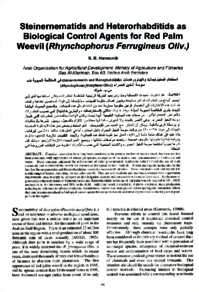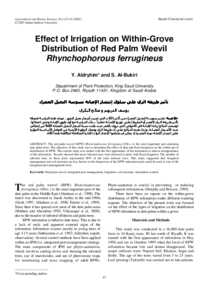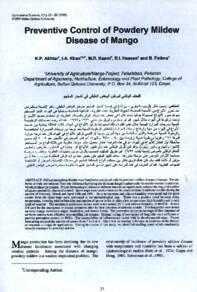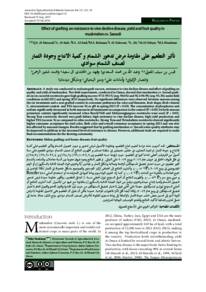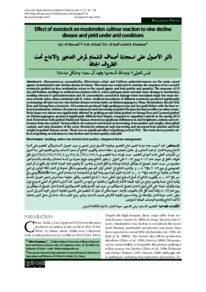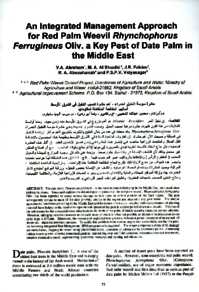Document
(.Steinernematids and heterorhabditids as biological control agents for red palm weevil (rhynchophorus ferrugineus oliv.
Publisher
Sultan Qaboos university
Gregorian
1998
Language
English
Subject
English abstract
Chemical insecticides have long been considered as the primary method of insect control, but their use has been associated with suppression of non-target species, emergence of resistant strains, contamination of food crops and water. These concerns enhanced the enforcement of strict governmental regulations which limited the use of such chemicals and stimulated the search for alternative biological control methods. Entomopathogenic nematodes in the families Steinernematidae and Heterorhabditidae received a considerable attention. These nematodes seek and rapidly kill a wide range of insects, including the red palm weevil. They are safe to plants and mammals, exempt from registration requirements, easy to apply by sprayers or drip irrigation systems and compatible with many chemicals. Application of genetically enhanced strains of Steinernematids and Heterorhabditids to larvae of red palm weevils resulted in 95 - 100% mortalities in the laboratory and 50% in the field. Additional work is needed to improve virulence, mass production technologies, tolerance to adverse conditions. formulations, and release strategies of entomopathogenic nematodes before they can be commercialized as biological control agents for red palm weevils and other cryptic insects attacking aerial plant parts in the region.
Member of
ISSN
2410-1079
Resource URL
Citation
Hanounik, S. B. (1998). Steinernematids and heterorhabditids as biological control agents for red palm weevil (rhynchophorus ferrugineus oliv.). Journal of Agricultural and Marian Sciences, 3 (1), 95-102.
Arabic abstract
لقد اعتبرت المبيدات الكيميائية ومنذ زمن بعيد الطريقة الرئيسية لمكافحة الحشرات، ولكن استخدامها أدى إلى انحسار أنواع من الحشرات لم تكن مستهدفة وظهور فصائل مقاومة للمبيدات، بالإضافة إلى تلوث المحاصيل الغذائية والماء. لقد أدت هذه الاعتبارات إلى استصدار قوانين حكومية صارمة تحد من استخدام مثل هذه المبيدات، وتشجيع البحوث الهادفة لإيجاد طرق المكافحة الحيوية البديلة، وقد حازت عائلتي (الستينرنيمائيد، والهيتر ورهابدتيدا) التي تصيب الحشرات بالأمراض الاهتمام الأكبر، من صفات هذه النيماتودا الطبيعية أنها تبحث وتقتل أنواعا مختلفة من الحشرات التي تشمل سوسة النخيل الحمراء. وهي لا تضر بالنبات ولا الحيوان، كما أنها معفاة من الالتزام بالتسجيل، ويسهل نشرها بالرشاشات أو بواسطة الري بالتنقيط. ويمكن أن تعيش مع العديد من الكيماويات. أدى استخدام بعض من هذه النيماتودا المحسنة الجينات إلى موت 95-100% من يرقات سوسة النخيل الحمراء داخل المختبر، أما في الحقل فقد ماتت 50% من اليرقات. بناء عليه فإن هنالك حاجة ماسة إلى تكثيف العمل نحو تقوية تشاط هذه النيماتودا، ولإيجاد التقنيات اللازمة لإنتاجها بكثرة، ودراسة إمكانية مقاومتها للظروف الصعبة، وتحديد مواصفات تنشئتها، ووضع الإستراتيجيات اللازمة لتوزيعها، وذلك قبل نشرها تجاريا لمكافحة سوسة النخيل الحمراء والآفات المتخفية التي تصيب الأجزاء العلوية من النباتات المزروعة في المنطقة.
Category
Journal articles

